
What is a Compliance Audit?
A compliance audit is a comprehensive review of an organization’s adherence to regulatory guidelines.
In the context of Professional Service Automation (PSA), it ensures that the software and its processes align with industry standards and best practices. This audit can be internal, conducted by members of the organization, or external, executed by third-party agencies.
Importance of Compliance Audits
Ensuring compliance is crucial for several reasons:
1. Risk Mitigation: It helps in identifying and rectifying potential risks, ensuring that the organization is not susceptible to legal repercussions or financial penalties.
2. Operational Efficiency: By adhering to industry standards, organizations can streamline their operations, leading to increased productivity and efficiency.
3. Building Trust: Demonstrating compliance can enhance an organization’s reputation, fostering trust among clients and stakeholders.
4. Financial Management: Proper compliance ensures that financial processes are transparent and accurate. This is where tools like finance management software come into play, ensuring that all financial operations are compliant with industry standards.

Why Compliance audit is so important?
Calculating Compliance Audit
Formula:
Compliance Score = (Number of Compliant Processes/Total Processes) x 100
Example:
If an organization has 100 processes and 90 of them are compliant:
Compliance Score=(90/100) x100=90
Compliance Audit vs Other Audits
While a compliance audit focuses on adherence to regulations, other audits might emphasize different aspects:
1. Financial Audits: Concentrate on the accuracy of financial statements and transactions. Finance management software can be instrumental in ensuring financial accuracy.
2. Performance Audits: Evaluate the effectiveness and efficiency of operations.
3. Information Systems Audits: Examine the management controls within an IT infrastructure.
| Aspect | Compliance Audit | Other Audits (e.g., Financial Audit, Operational Audit) |
|---|---|---|
| Purpose | Ensure adherence to specific laws, regulations, or industry standards. | Evaluate financial records, internal processes, or overall operational efficiency. |
| Focus | Specific regulatory or compliance requirements. | Financial data, internal controls, operations, or other specific areas as determined by the audit scope. |
| Scope | Narrow, with a primary focus on compliance with specific rules. | Broader, covering various aspects of an organization’s operations. |
| Reporting | Emphasis on non-compliance findings and recommendations for corrective actions. | Report may include findings on inefficiencies, mismanagement, or financial irregularities, with recommendations for improvement. |
Utilizing Compliance Audit
Once the audit is complete, the results can be used in various ways:
1. Improvement Plans: Identify areas of non-compliance and create action plans for improvement.
2. Training: Use the results to train employees, ensuring they understand the importance of compliance and how to achieve it.
3. Resource Management: Allocate resources more effectively based on the audit’s findings. For instance, if there’s a need for better time tracking, tools like KEBS timesheet software can be implemented.
4. Project Management: Enhance project management strategies by integrating compliant processes. KEBS project management software can be a valuable asset in this regard.
Ready to Optimize Your Compliance Audits?
KEBS, a leading PSA software, plays a pivotal role in ensuring compliance. With features like automated time tracking, KEBS ensures that processes are not only efficient but also compliant.
KEBS offers tools like employee 360 to ensure that resource allocation and management are in line with industry standards. Ensure financial operations are transparent and accurate with KEBS finance management software.

KEBS Reports
Ready to ensure your organization’s compliance with KEBS? Reach out for a demo or contact us today!



